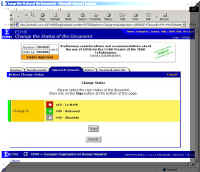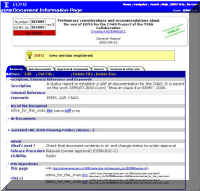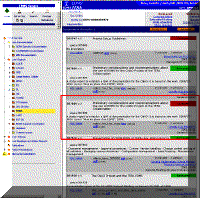7. DOCUMENT STATUSES AND VERSIONING
Documents have one life-cycle and depending where they are in the life-cycle they have a corresponding status. The standard lifecycle for a document (see Figure 43) is
-
In-Work
-
Under-Approval
-
Released and
-
Obsolete
Other lifecycles can be programmed if required, in accordance with the Quality Assurance Plan of your Project or Division.
7.1 HOW TO CHANGE THE STATUS OF A DOCUMENT
Note! Changing the status of a document that follows a certain release procedure is subject to restrictions in the workflow procedures. The EDMS-project's representatives define and control these restrictions, not the EDMS support team. The EDMS support team only helps with the definition of the authorisation procedures and their implementation in the EDMS.
Whatever your role is in the authorisation process, you must have been given the correct privileges to change the status of a document.
Go to the
document page (similarly as in Figure 14). Click on the Approval
and Comments tab. Click on the Change
Status Button. A new page, Figure 43 is displayed and where the
different possible statuses that the document now can take are shown.
Selecting one of the radio buttons and activating the![]() button
updates the status of the document. In the example the document goes back
into “Released”.
button
updates the status of the document. In the example the document goes back
into “Released”.
Figure 43 – Changing document status
Note: Approve any subdocuments before approving the compound document (see Compound Documents Section 6.12).7.2 VERSIONING
Once a document has been approved, it can be modified only via what is known as a versioning process. To create a new version of a document please access its Document Page, see Figure 44. The versioning procedure is:
1) On the summary tab of the released document page, click on New Version.
Figure 44 – Creating a new version
2) The new version of the document is created, and its document page is now displayed, Figure 45. Both document versions have the same EDMS Project document number and EDMS internal reference, but the version indices are different, Figure 46.
Figure 45 – New version is created.

Figure 46 – Resulting version index generated.
The files contained in the document are automatically copied into the new version, which is in status “In Work” by default, and can thus be edited. To replace the copied files by new ones, please follow the procedures described in Sections 6.5 and 6.6.
3) Go back to EDMS Navigator by clicking on Navigator in the Navigation Bar.
4) The new version of the document is automatically attached to the same node(s) as the predecessor, Figure 47.
Figure 47 – Result of a versioning action in the EDMS Navigator.
Note: Only one version of a document can be valid at any given moment. A new version of a document can be released only when its predecessor is Obsolete.



